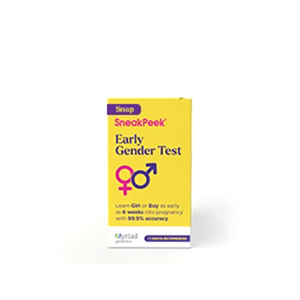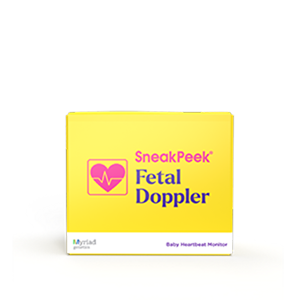Published on April 10th, 2023 and Updated on January 16th, 2024
Check out SneakPeek Gender Test to find out your baby’s gender as early as 6 weeks at over 99% accuracy1!
From getting busy every day to doing headstands after sex, couples trying for a baby have lots of myths to sift through when it comes to enhancing their chances of conception.
Sad to say, the science here is fairly unanimous: as of today, there aren’t any studies showing evidence-backed methods for boosting chances of conception post-coitus.
The good news? There is empirical evidence to back a handful of practices that may promote your and your partners’ fertility before (and sometimes while) you’re in the bedroom so you can finally start watching out for those signs of conception.
Below, we touch on some helpful tips for boosting your chances of conception—after unprotected sex, before sex, and during sex.
How to Optimize Chances of Conception After Sex
Wondering what to do after sex to conceive? While one of the most effective ways to boost fertility is to build a lifestyle that lends itself to fertility before you have sexual intercourse with your partner, there are a few ways you might try elevating your chances of conception right after you get at it:
- After sex, stay horizontal – Maintaining a horizontal position right after unprotected sex is one of the simplest ways to give sperm a boost on their odyssey. Do your best to avoid getting up to use the facilities (or make yourself a snack) for at least 3 minutes; this may help to minimize gravity’s effect on your babymaking mission. You can even try sliding a pillow beneath your pelvis for an extra sperm motility nudge.
- Do it again – Having sexual intercourse regularly, particularly around the time of your menstrual cycle when you ovulate, will give you and your partner the best chances of conceiving and getting pregnant. Women are most fertile for some 6 days each month, and getting busy during those days is one of the best ways to optimize your chances of conception (we’ll cover this in more detail later!).
- Keep up with pro-fertility lifestyle habits – Tuning up your lifestyle to make it fertility friendly is one of the best ways to prepare you and your body for pregnancy, whether that’s abstaining from alcohol, getting your heart rate up daily, or avoiding excess stress. Do your best to stick to those healthy habits after sex! The better you can stick to these practices, the higher the likelihood you and your partner will stick the landing.
How to Optimize Chances of Conception Before Sex
According to the Journal of Sexual Medicine, most couples only spend 3 to 7 minutes engaging in penetrative sex while they’re getting intimate. That leaves plenty of time to do your homework before you’re off to the races—and the following three strategies take the cake for augmenting conception chances before it’s time to make some babies.
Find Your Fertile Window
When it comes to the business of making babies, one of the most fundamental factors to set in place is timing. Specifically, timing your babymaking efforts to align with your ovulation schedule.
Most women are most fertile for approximately 6 days each reproductive cycle, a period known as the fertile window. An excellent way to identify yours is by getting into the habit of tracking ovulation each month by using fertility awareness techniques.
Women can use the following three markers to ascertain when they’re most fertile:
- Vaginal mucus – Vaginal discharge alters in consistency at different points in your monthly cycle. Vaginal discharge that’s thin, creamy, tacky, or absent indicates a low fertility period. During a high fertility period, it will appear stringy and slippery, like uncooked egg whites. This consistency makes it easier for sperm to swim their way up the fallopian tube toward a recently ovulated egg—just like a slip ‘n slide!
- Basal body temperature – Basal body temperature (BBT) refers to the temperature of your body in a prolonged state of rest. During ovulation, it typically jumps up by approximately half a degree (Fº). To track ovulation using this method, you’ll need a BBT thermometer which is more sensitive to heat (some even come with an app to more easily track your fertile windows!)
You’ll take your BBT at the same time each morning upon waking up—before you have a chance to engage in other activities that can raise your temperature. It’s recommended you keep a record of your BBT for at least 3 months to get an accurate picture of your ovulation schedule.
- Cervical position – The position of the cervix changes throughout the reproductive cycle and during pregnancy. During a high fertility period, the cervix retreats further up, allowing for more room during intercourse. In the low fertility period following ovulation, it’ll sit lower down in the body.
You can feel the position of your cervix manually by inserting your fingers into your vagina. But if you don’t feel comfortable using this method (or gauging how “high” or “low” your cervix feels), the other fertility awareness techniques can work just as well.
If you’re not yet in the habit of tracking ovulation yourself, you can also use an ovulation calculator (like this one from the US Department of Health & Human Services) to get a ballpark estimation of your fertility window.
Try Fertility Supplements
Certain micronutrients play a key role in boosting fertility, so integrating them into your diet through supplements may encourage conception to occur. If you aren’t confident you can meet your daily needs through food, try looking for formulas that include:
- Folic acid
- Vitamin D
- Vitamin B12
- L-arginine
For a comprehensive list of foods that can help with implantation, check out our blog post on foods to eat during 2 week wait.
Prioritize Pro-Fertility Lifestyle Habits
Both you and your partner can try promoting your respective (and collective) fertility potential by nixing some unhealthy habits and swapping them for a fertility-forward lifestyle.
Reproductive experts agree that any of the following may stymy couples’ chances of getting pregnant:
- Smoking – Smoking tobacco has been shown to depress fertility in both men and women. Some research also suggests smoking marijuana can injure sperm health, sperm count, and sperm motility in men.
- Alcohol – Even moderate alcohol use has been shown to compromise female reproductive health and fertility. In men, alcohol use has been shown to interfere with the development of healthy sperm.
- Stress – Stress can be detrimental to health in various ways, including reproductive potential in both men and women. One study showed women with elevated levels of alpha-amylase, a compound found in saliva during periods of psychological stress, was statistically less likely to conceive.
- Heat-exposed sperm – Healthy sperm develop in climates that are slightly cooler than the rest of the body. If you’re routinely trying to get pregnant, be sure your partner is on board to help his swimmers stay cool. Avoiding tight undies, taking breaks from hot environments (no more saunas!), and going on quick walks between long periods of sitting may all help to air out the boys and promote a healthy sperm count.
- Certain medications – Just like recreational drugs, select prescription drugs may not be fertility-friendly. These include:
- Some non-steroidal anti-inflammatory drugs (NSAIDs)
- Some psychiatric medications
- Some anti-epileptic medications
- Chemotherapy medications
- Some antibiotics
For some couples, it might not be realistic to eliminate certain drugs from the bathroom
cabinet. Before discontinuing any medications, be sure to consult with your healthcare
provider.
How to Optimize Chances of Conception During Sex
The potential to make babies is already built into our bodies, from the hormonal cycles we move through each month to the sheer arrangement of our physiologies. These three tricks may offer an extra measure of support when it’s time to get conjugal
Choose the Right Lubrication
Certain common lubricants, whether found in pharmacies or organic, may inhibit fertility by making it harder for sperm to move through the fallopian tube and the rest of the female anatomy. You may want to avoid the following when you’re having sex to conceive:
- KY jelly
- Saliva
- Olive oil
- Astroglide
If you need some extra slip, try using canola oil or Pre-Seed, a pH-balanced lube that mimics fertile vaginal conditions (and is specifically designed for couples trying for a baby).
Try Out Fertility-Friendly Positions
There’s no sexual position that’s proven to increase chances of conception, but some postures may give sperm a boost sheerly by their physics. Prioritize positions that:
- Have the male partner on top – The same principle applies here as in the post-sex “stay horizontal” tip: Gravitate towards positions where gravity can work with sperm cells rather than against them. Missionary position is a couples’ crowd favorite for a fertilized egg!
- Encourage deeper penetration – Instead of forcing sperm to swim their personal English channel, elect a position that gives them a shortcut to the egg. Man-from-behind positions (colloquially called “Doggy Style”) naturally deposit sperm closer to the cervix, which may save them a ton of “tailwork.”
Find Support Before, During, and After Your Pregnancy Journey with SneakPeek
Trying for a baby can be hard work—emotionally, physically, and otherwise! Whatever methods you’re using to encourage conception, remember to give yourself the same patience when taking a pregnancy test and compassion you’ll offer your future family.
When you’ve officially set out on your path to parenthood, SneakPeek is your go-to resource for getting the facts on your pregnancy and your baby. With our at-home Early Gender DNA SneakPeek Test, you can discover your baby’s gender as early as 6 weeks into your pregnancy —that’s months before your gender reveal ultrasound!
Here’s how it works: you’ll take your sample at home, then send it to our CLIA-certified labs. Once received, we’ll send you back physician-reviewed results—and you’ll even get a comprehensive downloadable assessment you can share with your OBGYN.
SneakPeek is OBGYN’s #1 recommended early gender blood test, and more than 1 million moms have trusted us to deliver the news they most want to hear. Get clarity and confidence on your journey to motherhood by exploring SneakPeek’s at-home test kits today.
Sources:
- Fertility Network UK. Conception Tips. https://fertilitynetworkuk.org/fertility-faqs/factors-affecting-fertility/lifestyle-fertility/conception-tips/
- US Department of Health & Human Services. Ovulation calculator. https://www.womenshealth.gov/ovulation-calculator
- UNC School of Medicine. Cervical mucus monitoring. https://www.med.unc.edu/timetoconceive/study-participant-resources/cervical-mucus-testing-information/#Type_1_8211_lowest_fertility
- Johns Hopkins Medicine. Calculating Your Monthly Fertility Window. https://www.hopkinsmedicine.org/health/wellness-and-prevention/calculating-your-monthly-fertility-window
- VeryWell Family. What Does a Fertile Cervix Look and Feel Like? https://www.verywellfamily.com/what-does-a-fertile-cervix-look-and-feel-like-1960297#toc-cervical-changes-during-ovulation
- National Health Service UK. How can I improve my chances of becoming a dad? https://www.nhs.uk/common-health-questions/mens-health/how-can-i-improve-my-chances-of-becoming-a-dad/
- National Institutes of Health. What lifestyle and environmental factors may be involved with infertility in females and males? https://www.nichd.nih.gov/health/topics/infertility/conditioninfo/causes/lifestyle
- National Institute of Alcohol Abuse and Alcoholism. Alcohol’s Effects on Female Reproductive Function. https://pubs.niaaa.nih.gov/publications/arh26-4/274-281.htm
- The Alcohol and Other Drug Thesaurus: A Guide to Concepts and Terminology in Substance Abuse and Addiction. Alcohol’s Effects on Male Reproduction. https://pubs.niaaa.nih.gov/publications/arh22-3/195.pdf
- National Institutes of Health. NIH study indicates stress may delay women getting pregnant. https://www.nih.gov/news-events/news-releases/nih-study-indicates-stress-may-delay-women-getting-pregnant
- Parents. How Medications Can Affect Your Fertility. https://www.parents.com/getting-pregnant/pre-pregnancy-health/how-medications-can-affect-your-fertility/
- Healthline. Babymaking 101: Ways to Get Pregnant Faster. https://www.healthline.com/health/sex-for-pregnancy
- Healthline. 11 Best Fertility Supplements, According to a Dietitian. https://www.healthline.com/health/fertility/fertility-vitamins
- Healthline. How Long Should Sex Really Last? https://www.healthline.com/health/healthy-sex/how-long-should-sex-last

Shop Our Products
SneakPeek aims to provide the most accurate and up-to-date information to help our readers make informed decisions regarding their health before, during, and after pregnancy. This article was written based upon trusted scientific research studies and/or articles. Credible information sources for this article are cited and hyperlinked.





